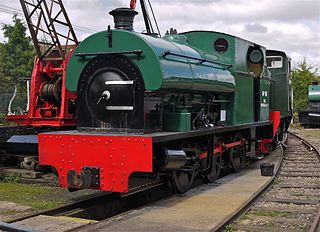
The Narrow Gauge Railway Museum is a purpose-built museum dedicated to narrow-gauge railways situated at the Tywyn Wharf station of the Talyllyn Railway in Tywyn, Gwynedd, Wales.

The Tanfield Railway is a 4 ft 8+1⁄2 instandard gauge heritage railway in Gateshead and County Durham, England. Running on part of a former horse-drawn colliery wooden waggonway, later rope & horse, lastly rope & loco railway. It operates preserved industrial steam locomotives. The railway operates a passenger service every Sunday, plus other days, as well as occasional demonstration coal, goods and mixed trains. The line runs 3 miles (4.8 km) between a southern terminus at East Tanfield, Durham, to a northern terminus at Sunniside, Gateshead. Another station, Andrews House, is situated near the Marley Hill engine shed. A halt also serves the historic site of the Causey Arch. The railway claims it is "the world's oldest railway" because it runs on a section dating from 1725, other parts being in use since 1621.

The East Kent Railway (EKR) is a heritage railway in Kent, England. It is located at Shepherdswell station on the London and Chatham to Dover mainline. The line was constructed between 1911 and 1917 to serve the Kent Coalfields. See East Kent Light Railway for details of the original lines. The Kent Collieries were mostly a failure with only Tilmanstone on the line producing any viable commercial coal and commercial traffic over the line. The line is operated by heritage diesel locomotives. It is home to a collection of heritage diesel locomotives including a British Rail Class 08, DEMU and electric multiple units including an in service British Rail Class 404 built in the 1930s and a more modern British Rail Class 365, which is to be used as a restaurant and a major events venue.

The Bowes Railway, built by George Stephenson in 1826, is the world's only operational preserved standard gauge cable railway system. It was built to transport coal from pits in Durham to boats on the River Tyne. The site is a scheduled monument. The railway is open every week on Thursday, Friday and Saturday as well as on a number of event days throughout the year.
Peak Rail is a preserved railway in Derbyshire, England, which operates a steam and heritage diesel service for tourists and visitors to both the Peak District and the Derbyshire Dales.

Barrow Hill Roundhouse, until 1948 known as Staveley Engine Shed, is a former Midland Railway roundhouse in Barrow Hill, near Staveley and Chesterfield, Derbyshire, now serving as a railway heritage centre.

The Northamptonshire Ironstone Railway Trust operates a 1+1⁄2-mile (2.4 km) long heritage railway line at Hunsbury Hill, south-west of Northampton. The line is mainly dedicated to freight working, featuring many sharp curves and steep gradients which were typical of the industrial railway, but rides are available in a variety of vehicles including a converted brake van.

The Cambrian Heritage Railways is a heritage railway company, trust and society based at both Llynclys and Oswestry in its restored Oswestry railway station, Shropshire, England.

Sentinel Waggon Works Ltd was a British company based in Shrewsbury, Shropshire that made steam-powered lorries, railway locomotives, and later, diesel engined lorries, buses and locomotives.

The Scottish Industrial Railway Centre is an industrial heritage railway operated by the Ayrshire Railway Preservation Group. The centre owns a number of standard gauge steam locomotives and diesel locomotives as well as some narrow gauge items and an extensive collection of photographs.
R. & W. Hawthorn, Leslie and Company, Limited, usually referred to as Hawthorn Leslie, was a shipbuilder and locomotive manufacturer. The company was founded on Tyneside in 1886 and ceased building ships in 1982.
The Kettering Ironstone Railway was an industrial 3 ft narrow gauge railway that served the ironstone quarries around Kettering.

The Llanelli and Mynydd Mawr Railway is a heritage railway whose stated aims are to re-instate as much as possible of the former Llanelly and Mynydd Mawr Railway which closed in 1989.
The Hook Norton ironstone quarries (Brymbo) were ironstone quarries near Hook Norton in Oxfordshire, England. The quarries were in operation from 1899 to 1946 supplying ironstone to the Brymbo Steelworks in Wrexham and were served by the Brymbo Ironworks Railway, an extensive, 2 ft (610 mm) narrow gauge industrial railway.

North Dorset Railway is a heritage railway based at Shillingstone railway station on the former Somerset and Dorset Joint Railway in the United Kingdom.
The Great Central Railway (Nottingham) (formerly known as the Nottingham Heritage Railway) is a heritage railway located at the Nottingham Transport Heritage Centre (NTHC), on the south side of the village of Ruddington, in Nottinghamshire. The route consists of almost 10 miles (16 km) of the former Great Central Main Line from Loughborough South Junction (with the Midland Main Line) to Fifty Steps Bridge and the site of Ruddington's former GCR station, plus a branch line from Fifty Steps Bridge to Ruddington Fields station which is located on a former Ministry of Defence site next to Rushcliffe Country Park.

The Wellingborough Tramway was an industrial narrow-gauge railway that connected a series of ironstone mines and quarries with the Midland Railway and later with the ironworks on the north side of Wellingborough. In various forms, the tramway operated between 1875 and 1966.



















